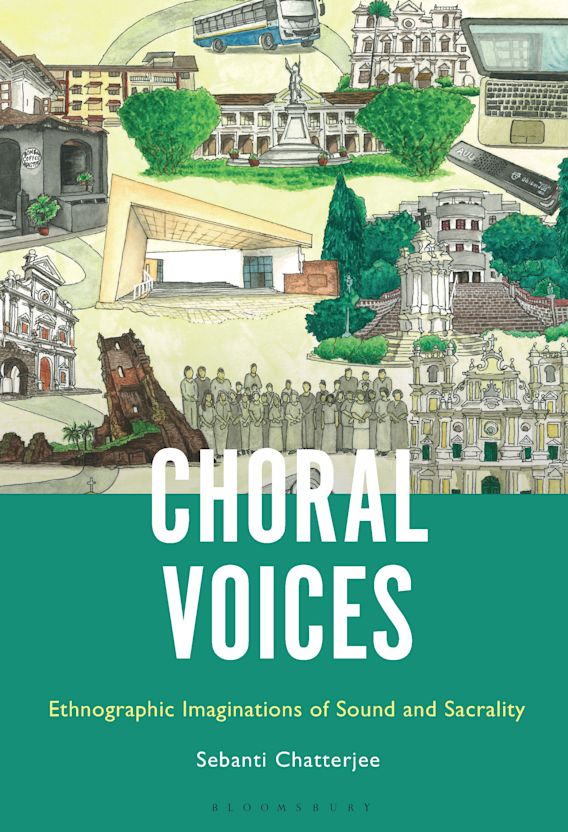
Sebanti Chatterjee’s captivating book Choral Voices: Ethnographic Imaginations of Sound and Sacrality (published by Bloomsbury in 2023) takes readers on a thought-provoking journey through the enchanting world of choral music. The book delves into the profound significance of choral music in various social, cultural, and religious contexts, providing an authentic account of its history and contemporary evolution in India, with a particular focus on the ex-colonial places of Goa and Shillong.
Chatterjee’s study is grounded in the Deleuzian philosophy of Art and Aesthetics, exploring the concepts of ‘assemblage’ and ‘deterritorialization.’ By critically examining the socio-cultural aspects of choir music beyond its traditional sacred space, the book highlights the interplay between music-making and the broader social fabric, occasionally touching upon the politics of music-making. Through ethnographic immersion, the author reveals the temporal imaginings of choral music, tracing its journey from the traditional Catholic-Christian evangelical movement centuries ago to its integration with regional and indigenous folk music over the decades. Ultimately, the book demonstrates how choral music has found its place in the global music market through various media and cultural platforms, often transcending its original sacred context.
Central to Chatterjee’s argument is the transformative power of choral music. The author explores the intertwined themes of ‘indigeneity’ and ‘sacrality,’ emphasizing their crucial role in the evolution of choral music, particularly under the influence of colonialism. Throughout the chapters, these themes intersect and interact, culminating in a new understanding of ‘sacred intent’ that defines the contemporary changes in sacred choir music, surpassing institutional definitions of religion and sacredness.
The book comprises six chapters, with the first chapter serving as an introduction to the subject matter. It familiarizes readers with key concepts such as the sacrality of choir music, indigeneity, piety, and nostalgia, which have shaped choral music in India and are instrumental in contextualizing the study. The second chapter focuses on the ‘making of the indigenous,’ exploring indigeneity in Sacred Christian Music on a global scale, with a deep focus on Goa and Shillong. Through fieldwork and literature review, the author sheds light on the politics and culture of colonial influences on indigenous music. The concept of Sonic Interculturality emerges, highlighting how indigenous and colonial music undergoes a reciprocal and transformative process. The chapter emphasizes that ‘mapping the indigenous’ does not merely preserve local artistic practices but also involves reconnecting with roots periodically.
In the third chapter, the author delves into ethnographic fieldwork in Shillong, specifically examining two choirs: the Shillong Chamber Choir and the Aroha Choir. The participation of the Shillong Chamber Choir in the reality show ‘India’s Got Talent 2011’ prompts an investigation into their unique journey as a sacred choir venturing beyond conventional sacred spaces and performing in secular musical arenas, incorporating mainstream Bollywood music into their compositions. This development showcases the emergence of the ‘Medley’ as a new musical genre, ‘deterritorializing’ choral music and reimagining its social and cultural boundaries. The fourth chapter takes readers to Goa, where the author explores the centrality of faith in the growth of choral music. Introducing the concept of ‘imperial affect,’ the author reveals the complex interaction between indigenous folk music and Christian choir music, resulting in the formation of sacro-indigenous repertoires of choral music that carry the essence of ‘restorative nostalgia’.
The fifth chapter delves into vocal dynamics and cultural rootedness, examining vocal techniques and their expression of sacred intent. The final chapter serves as a concluding reflection, summarizing the author’s justifications for choosing these specific fields of study and emphasizing the grand artistic ability of choral music to transcend traditional boundaries. The author argues for the need to decolonize knowledge and explore new perspectives in understanding and interpreting choral music.
Methodologically, the book breaks away from traditional ethnography by adopting a multi-sited approach and prioritizing embodied practices. Chatterjee’s engagement with the subject matter goes beyond mere participant observation, actively participating in singing, rehearsing, and playing instruments alongside the musicians. This experimental approach showcases the potential of ethnography as a method and highlights its relevance in interdisciplinary research. The writing style combines narrative immersion, sensory detail, storytelling techniques, and objective description, complemented by relevant theoretical and conceptual frameworks. This approach allows readers to connect with the subject matter on a personal level, bringing the research to life through vivid anecdotes and real-life experiences.
The book’s key contributions lie in its ability to bridge the gap between the academic study of music and lived experiences of communities, allowing readers to engage with the subject matter in a deeply personal and resonant manner. By intimately exploring the social, historical, and cultural contexts in which choral music thrives, Chatterjee invites us to appreciate the universal aspects of these traditions while celebrating their unique and idiosyncratic expressions. Epistemologically speaking, Sebanti Chatterjee explores an alternative history of knowledge coproduction that goes beyond the narratives of ‘epistemic violence’ upon the indigenous communities and culture. Therefore, this book in the upcoming days is going to be an asset both in terms of its methodological and scientific rigour, as well as in its quest for new epistemological pathways.
***
Akash Jash is a PhD research scholar at the Institute for Social and Economic Change, Bangalore.